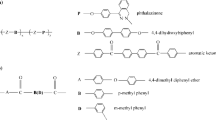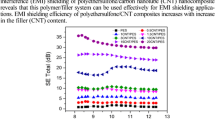Abstract
Silica hollow tube (SHT) nanofillers were fine distributed in poly(ether ketone ketone) (PEKK) to serve decently as sixth generation (6G) substrate films. Distinctly lower dielectric and thermal expansion characteristics were detected for all PEKKaxSHTy film sequence filled with proper amounts of SHT nanofillers. The dielectric characteristics detected for all PEKKaxSHTy film sequence diminished to a minimum, as SHT loads came near an optimal value of 8wt%. The LCTE evaluated for each PEKKaxSHTy film sequence reduced distinctly with increasing SHT loads. Suitable dielectric constant (εr) (2.26 at 1 MHz), and/or dielectric loss (tan δ) (0.0027 at 1 MHz) and/or Linear coefficient of thermal expansion (LCTE) (30.5 × 10−6/ °C) for 6G rapid-speed communication were detected for PEKKP700092SHT8 substrate film having 8wt% load of SHT nanofillers. Meanwhile, the beginning degradation temperatures estimated for all PEKKaxSHTy film sequence increased distinctly with increasing SHT loads. All free-volume-cavity characteristics estimated for all PEKKaxSHTy film sequence approached a highest value, as SHT loads came near an optimal value of 8wt%. Distinctly lower εr and tan δ were detected for PEKKa and PEKKaxSHTy having higher free-volume-cavity characteristics. Possible interpretations for the distinctly diminished dielectric and/or heat-resistant characteristics acquired for PEKKaxSHTy films are presented.














Similar content being viewed by others
References
Hu F, Chen B, Zhu K (2018) Full spectrum sharing in cognitive radio networks toward 5G: a Survey. IEEE Access 4(15):15754–15776
Fujita M, Nagatsuma T (2016) Photonic crystal technology for terahertz system integration terahertz physics, devices, and systems X: Advanced applications in industry and defense. SPIE 9856:67–76
Anjana PS, Sebastian MT, Suma MN, Mohanan P (2008) Low dielectric loss PTFE/CeO2 ceramic composites for microwave substrate applications. Int J ApplCeram Tec 5(4):325–333
David K, Berndt H (2018) 6G vision and requirements: is there any need for beyond 5G. IEEE Veh Technol 13(3):72–80
Cross W, Cross W, Kjerengtroen L, Kellar JJ (2005) Interphase variation in silane-treated glass-fiber-reinforced epoxy composites. J Adhes Sci Technol 19(3–5):279–290
Ji Y, Bai Y, Liu X, Jia K (2020) Progress of liquid crystal polyester (LCP) for 5G application. Adv Ind Eng Polym Res 3(4):160–174
Wang L, Liu C, Shen S, Xu M, Liu X (2020) Low dielectric constant polymers for high speed communication network. Adv Ind Eng Polym Res 3(4):138–148
Yung KC, Wang J, Yue TM (2006) Fabrication of epoxy-montmorillonite hybrid composites used for printed circuit boards via in-situ polymerization. Adv Compos Mater 15(4):371–384
Yung KC, Liem H, Choy H, Yue TM (2010) A study of critical processing technologies of liquid crystal polymer printed circuit board for high speed application. J Appl Polym Sci 116(4):2348–2358
Han L, Gao X (2016) Modeling of bending characteristics on micromachined RF MEMS switch based on LCP substrate. IEEE T Electron Dev 63(9):3707–3712
Shaman H, Almorqi S, Alamoudi A (2016) Ultra-wideband (UWB) bandpass filter with cascaded lowpass filter on multilayer liquid-crystal polymer (LCP) substrate. IETE J Res 62(1):63–67
Mcgarry MP, Iyer MK, Lee M (2021) Broadband millimeter-wave dielectric properties of liquid crystal polymer materials. IEEE T Comp Pack Man 12(1):192–194
Gonon P, Sylvestre A (2002) Dielectric properties of fluorocarbon thin films deposited by radio frequency sputtering of polytetrafluoroethylene. J Appl Phys 92(8):4584–4589
Zhang P, Zhao J, Zhang K, Bai R, Wang Y, Hua C, Li Y (2016) Fluorographene/polyimide composite films: mechanical, electrical, hydrophobic, thermal and low dielectric properties. Compos Part A Appl Sci Manuf 84:428–434
Subodh G, Manjusha M, Sebastian PJMT (2008) Thermal properties of polytetrafluoroethylene/Sr2Ce2Ti5O16 polymer/ceramic composites. J Appl Polym Sci 108(3):1716–1172
Sun H, Cooke RS, Bates WD, Wynne KJ (2005) Supercritical CO2 processing and annealing of polytetrafluoroethylene (PTFE) and modified PTFE for enhancement of crystallinity and creep resistance. Polymer 46(20):8872–8882
Dang ZM, Ma LJ, Zha JW, Yao SH, Xie D, Chen Q, Duan X (2009) Origin of ultralow permittivity in polyimide/mesoporous silicate nanohybrid films with high resistivity and high breakdown strength. J Appl Phys 105(4):044104
Feng Y, Wang CH, Liu SX (2016) Low dielectric constant of polymer based composites induced by the restricted polarizability in the interface. Mater Lett 185:491–494
Hao J, Wei Y, Li X, Mu J (2018) Poly (arylene ether ketone)s with low dielectric constants derived from polyhedral oligomeric silsesquioxane and difluorinated aromatic ketones. J Appl Polym Sci 135(15):46084
Kıvılcım N, Seçkin T, Köytepe S (2013) Porous pyridine based polyimide-silica nanocomposites with low dielectric constant. J Porous Mat 20(4):709–718
Kurinchyselvan S, Hariharan A, Prabunathan P, Gomathipriya P, Alagar M (2019) Fluorinated polyimide nanocomposites for low K dielectric applications. J Polym Res 26(9):1–15
Lin Q, Cohen SA, Gignac L, Herbst B, Klaus D, Simonyi E, Wu WL (2007) Low dielectric constant nanocomposite thin films based on silica nanoparticle and organic thermosets. J Polym Sci B Polym Phys 45(12):1482–1493
Pan DM, Zhou GK, Zhi XD, Hsu T, Yeh JT (2021) Performance of Nano-SiO2-Filled poly (ether ketone ketone) substrate for fifth-generation communication. J Electron Mater 50(9):5327–5337
Pavoski G, Kalikoski R, Souza G, Baldisserotto D, Brum LFW, Santos CD, Galland GB (2020) Antimicrobial high-density polyethylene (HDPE)/ZnO nanocomposites obtained by in situ polymerization. J Braz Chem Soc 31:1566–1574
Singha S, Thomas M, Insulation E (2008) Dielectric properties of epoxy nanocomposites. IEEE Trans Dielectr Electr Insul 15(1):12–23
Wang CY, Chen WT, Xu C, Zhao XY, Li J (2016) Fluorinated polyimide/POSS hybrid polymers with high solubility and low dielectric constant. Chin J Polym Sci 34(11):1363–1372
Zhang YH, Lu SG, Li YQ, Dang ZM, Xin JH, Fu SY, Li LF (2005) Novel silica tube/polyimide composite films with variable low dielectric constant. Adv Mater 17(8):1056–1059
Zhi XD, Lei ZW, Ou-Yang S, Hsu T, Yeh JT (2022) Performance of SiO2 filled functional polypropylene substrates for 5th Generation Communication. J Macromol Sci B 1–23
Zhou GK, Zhi XD, Pan DM, Hsu T, Yeh JT (2022) Fifth Generation Communication Performance of Poly (ether ketone ketone)/Modified Montmorillonite substrate. Macromol Res 30(2):107–115
Kumar SK, Benicewicz BC, Vaia RA, Winey KI (2017) 50th anniversary perspective: are Polymer nanocomposites practical for applications? Macromol 50(3):714–731
Lu Y, Zhang S, Geng Z, Zhu K, Zhang M, Na R, Wang G (2017) Hybrid formation of graphene oxide-POSS and their effect on the dielectric properties of poly (aryl ether ketone) composites. New J Chem 41(8):3089–3096
Hsu T, Wang Y, F, Allen S (2009) Polymics Ltd, US Patent 0113688A1
Sun QM, Wang Y, F,Q. M, Sun YF, Wang (2010) Orima Ltd, CN Patent,101812170A.
Wang Y, F, Hsu. T, Allen S (2015) Polymics Ltd. H. CN Patent 102924898A
Miyaji F, Watanabe Y, Suyama Y (2003) Morphology of silica derived from various ammonium carboxylate templates. Mater Res bull 38(13):1669–1680
Huang Y, Wei X, Liu L, Yu H, Yang J (2018) A novel pore-free strategy via interfacial effects in nanocomposites to produce polyethylene with ultra-low dielectric constants. Mater Lett 232:86–91
Okaji M (1999) Yamada. N, Kato. H, Nara. K, Bull, vol 46. NRLM, p 263
Tao SJ (1922) Positronium annihilation in molecular substances. J Chem Phys 56(11):5499–5510
Kivilcim N, SeÁkin T (2019) Mater Sci: Indian J 8:25
Deng Q, Sundar CS, Jean YC (1992) Pressure dependence of free-volume hole properties in an epoxy polymer. J Phys Chem 96(1):492–495
Wang YY, Nakanishi H, Jean YC, Sandreczki TC (1990) Positron annihilation in amine-cured epoxy polymers—pressure dependence. J Polym Sci B Polym Phys 28(9):1431–1441
Fitaroni LB, de Lima JA, Cruz SA, Waldman WR (2015) Thermal stability of polypropylene–montmorillonite clay nanocomposites: limitation of the thermogravimetric analysis. Polym Degrad Stab 111:102–108
Golebiewski J, Galeski A (2007) Thermal stability of nanoclay polypropylene composites by simul0taneous DSC and TGA. Compos Sci Technol 67(15–16):3442–3447
Kotsilkova R, Petkova V, Pelovski Y (2001) Thermal analysis of polymer-silicate nanocomposites. J ThermAnal Calorim 64(2):591–598
Geng Z, Huo M, Mu J, Zhang S, Lu Y, Luan J, Wang G (2014) Ultra low dielectric constant soluble polyhedral oligomeric silsesquioxane (POSS)–poly (aryl ether ketone) nanocomposites with excellent thermal and mechanical properties. J Mater Chem C 2(6):1094–1103
Hong JI, Winberg P, Schadler LS, Siegel RW (2005) Dielectric properties of zinc oxide/low density polyethylene nanocomposites. Mater Lett 59(4):473–476
Wang C, Wang TM, Wang QH (2013) Low-dielectric, nanoporous polyimide thin films prepared from block copolymer templating. Express Polym Lett 7(8):667–672
Lee YJ, Huang JM, Kuo SW, Lu JS, Chang FC (2005) Polyimide and polyhedral oligomeric silsesquioxane nanocomposites for low-dielectric applications. Polym 46(1):173–181
Liu L, Li XF, Yan Q, Li QK, Zhang XH, Deng M, Luo Y (2017) Uniform and perfectly linear current–voltage characteristics of nitrogen-doped armchair graphene nanoribbons for nanowires. Phys Chem Chem Phys 19(1):44–48
Author information
Authors and Affiliations
Corresponding author
Ethics declarations
Conflict of interest
No conflict of interest exists in the submission of this manuscript, and manuscript is approved by all authors for publication. I would like to declare on behalf of my co-authors that the work described was original research, which has not been published previously, and not under consideration for publication elsewhere, in whole or in part.
Additional information
Publisher’s Note
Springer Nature remains neutral with regard to jurisdictional claims in published maps and institutional affiliations.
Zhi-wen Lei and Ning Ma are co-first authors.
Rights and permissions
Springer Nature or its licensor (e.g. a society or other partner) holds exclusive rights to this article under a publishing agreement with the author(s) or other rightsholder(s); author self-archiving of the accepted manuscript version of this article is solely governed by the terms of such publishing agreement and applicable law.
About this article
Cite this article
Lei, Zw., Ma, N., Hsu, T. et al. Poly(ether ketone ketone)/Silica nanotubes substrate films and their Sixth Generation Communciation performance. J Polym Res 31, 33 (2024). https://doi.org/10.1007/s10965-024-03878-9
Received:
Accepted:
Published:
DOI: https://doi.org/10.1007/s10965-024-03878-9




